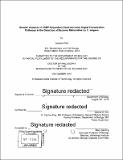Genetic analysis of cGMP-dependent chemosensory signal transduction pathways in the detection of bacterial metabolites by C. elegans
Author(s)
Park, Jaeseok,Ph.D.Massachusetts Institute of Technology.
Download1138019709-MIT.pdf (7.521Mb)
Other Contributors
Massachusetts Institute of Technology. Department of Biology.
Advisor
Dennis H. Kim.
Terms of use
Metadata
Show full item recordAbstract
The ability of metazoans to sense and interpret the external chemical environment is conferred by the chemosensory nervous system governing the senses of smell and taste. Chemosensory neurons convey external stimuli in the form of electrical impulses, as well as by changes in gene expression. This thesis describes the genetic elucidation of a Caenorhabditis elegans molecular pathway that transduces the presence of pathogens to activate the transcription of a neuroendocrine ligand. Previously, our group has showed that secondary metabolites produced by the pathogen P. aeruginosa cause an expression pattern change of the gene coding for the C. elegans TGF-beta ligand DAF-7. Using forward and reverse genetic approaches, we identified several cGMP-related components that are essential for the pathway, including a subunit for cyclic nucleotide-gated channels, CNG-2, and a cGMP-dependent kinase, EGL-4. We show that while CNG-2 induces daf-7 expression in a calcium-dependent manner, EGL-4 likely works in a calcium-independent manner to regulate daf-7 expression. Our data suggest that EGL-4 acts by selectively promoting the transcription of neuronal genes in response to appropriate stimuli. In a separate set of experiments, we also showed that the expression of daf-7 is discretely regulated by different classes of intraflagellar transport proteins that function in cilia.
Description
Thesis: Ph. D., Massachusetts Institute of Technology, Department of Biology, 2019 "September 2019." Cataloged from PDF version of thesis. Includes bibliographical references.
Date issued
2019Department
Massachusetts Institute of Technology. Department of BiologyPublisher
Massachusetts Institute of Technology
Keywords
Biology.